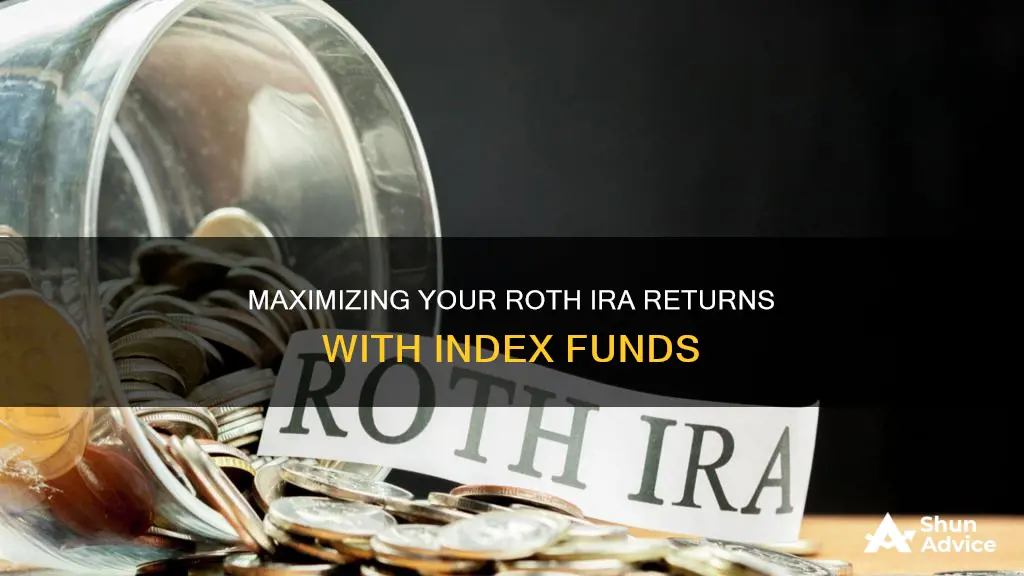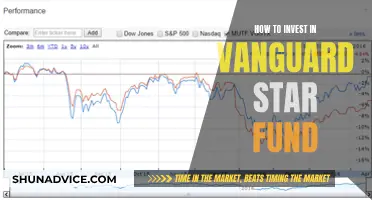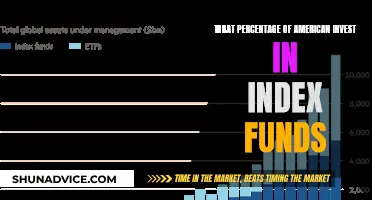
A Roth IRA is a powerful tool for retirement savings. It allows you to grow your money tax-free and make tax-free withdrawals after the age of 59 and a half. When choosing investments for your Roth IRA, it's important to consider your risk tolerance, investment horizon, and tax implications. While there is no one-size-fits-all approach, index funds and exchange-traded funds (ETFs) are often recommended for their low fees and diversification benefits. Here are some of the best index funds to consider for your Roth IRA:
- U.S. Stock Index Funds: These funds track a specific stock index, such as the S&P 500 or the Russell 2000, providing diversification across a range of U.S. companies.
- U.S. Bond Index Funds: Bond funds offer lower returns than stocks but can help reduce volatility in your portfolio. They are a good option for investors seeking stable and secure sources of income.
- Global Stock Index Funds: Investing in international stock index funds can further diversify your portfolio by providing exposure to companies and markets outside the U.S.
- Dividend Stock Funds: Dividend stock funds invest in companies that pay out regular dividends, providing a steady income stream. Dividends can be reinvested to grow your Roth IRA even further.
- Target-Date Funds: These funds automatically adjust their asset allocation based on your chosen retirement year, offering a hands-off approach to investing.
When selecting specific funds, consider factors such as expense ratios, minimum investment requirements, and historical returns. Remember to review and rebalance your portfolio periodically to ensure it aligns with your financial goals and risk tolerance.
| Characteristics | Values |
|---|---|
| Investment type | Index funds, stocks, bonds, mutual funds, exchange-traded funds (ETFs), REITs |
| Investment strategy | Long-term, buy-and-hold, diversified, low-cost |
| Tax implications | Tax-free growth and withdrawals after age 59 1/2 |
| Risk profile | Varies depending on investment type and investor's risk tolerance |
| Returns | Varies depending on investment type and market performance |
| Fees | Generally low fees for index funds and ETFs |
What You'll Learn

U.S. stock index funds
When choosing a U.S. stock index fund for your Roth IRA, consider the fund's diversification, fees, and performance. Here are some specific U.S. stock index funds that meet these criteria:
- Vanguard S&P 500 ETF (VOO): This ETF tracks the S&P 500 index and is backed by Vanguard, a well-respected name in the industry. It has an expense ratio of 0.03%, which means you only pay $3 annually for every $10,000 invested.
- SPDR S&P 500 ETF Trust (SPY): With hundreds of billions in the fund, SPY is one of the most popular ETFs. It is sponsored by State Street Global Advisors and tracks the S&P 500 index. The expense ratio is 0.095%, or $9.50 annually for every $10,000 invested.
- IShares Core S&P 500 ETF (IVV): This ETF is sponsored by BlackRock, one of the largest fund companies. It tracks the S&P 500 and has an inception date of 2000, making it a long-tenured player. The expense ratio is 0.03%, or $3 annually for every $10,000 invested.
- Schwab S&P 500 Index Fund (SWPPX): This mutual fund is sponsored by Charles Schwab and has been around since 1997. It has tens of billions in assets and a low expense ratio of 0.02%, or $2 annually for every $10,000 invested.
- Vanguard Russell 2000 ETF (VTWO): This ETF tracks the Russell 2000 Index, which includes 2,000 of the smallest publicly traded companies in the U.S. As a Vanguard fund, it focuses on keeping costs low for investors, with an expense ratio of 0.10%, or $10 annually for every $10,000 invested.
- Vanguard Total Stock Market ETF (VTI): The VTI covers the entire universe of publicly traded stocks in the U.S., including small, medium, and large companies across all sectors. With Vanguard as the sponsor, you can expect low costs, and the expense ratio is 0.03%, or $3 annually for every $10,000 invested.
When choosing a U.S. stock index fund, it's important to consider your financial goals, risk tolerance, and the level of diversification you need in your portfolio. Remember to do your own research and consult with a financial advisor before making any investment decisions.
Emergency Fund Placement: Where in Your Portfolio?
You may want to see also

U.S. bond index funds
When it comes to investing in a Roth IRA, U.S. bond index funds can be a great option for those seeking a long-term, diversified investment portfolio. Here are some things to keep in mind:
Benefits of U.S. Bond Index Funds
Factors to Consider
When choosing a U.S. bond index fund, it is important to consider the fund's benchmark index, level of diversification, expense ratio, and minimum investment requirements. Look for funds with broad diversification, low expense ratios, and no minimum investment requirements or transaction fees.
Recommended U.S. Bond Index Funds
- Fidelity U.S. Bond Index Fund (FXNAX): This fund has a long track record, low expense ratio (0.025%), and no minimum investment or transaction fees. It follows the Bloomberg U.S. Aggregate Bond Index and has a mix of U.S. Treasurys, corporate bonds, and other debt securities.
- Vanguard Total Bond Market Index Fund Admiral Shares (VBTLX): With a low expense ratio of 0.05% and a long track record since 2001, this fund is similar to FXNAX but requires a $3,000 minimum investment. It tracks a modified version of the Bloomberg U.S. Aggregate Bond Index.
- Schwab U.S. Aggregate Bond Index Fund (SWAGX): SWAGX offers transparent and affordable exposure to a large number of investment-grade government and corporate bonds. It has a low expense ratio of 0.04% and no minimum investment requirement.
- Northern Bond Index Fund (NOBOX): NOBOX provides exposure to the Bloomberg U.S. Aggregate Bond Index and has a long track record since 2007. It has a low expense ratio of 0.07% but requires a minimum investment of $2,500.
- IShares U.S. Aggregate Bond Index Fund (BMOAX): This fund tracks a broad portfolio of U.S. bonds and has a decent track record since 2011. It offers diversification but comes with a higher expense ratio of 0.35% and a minimum investment requirement of $1,000.
Remember to do your own research and consult with a financial advisor to determine if these funds align with your investment goals, risk tolerance, and financial situation.
Arbitrage Funds: Strategic Investment Opportunities for Savvy Investors
You may want to see also

Global stock index funds
When constructing a portfolio for your Roth IRA, you have a variety of investment options to choose from. A Roth IRA is a type of tax-advantaged individual retirement account that enables tax-free growth from any income, dividends or capital gains realized within.
If you're building a Roth IRA to save for retirement, you should design a portfolio using a long-term, buy-and-hold approach. A strong portfolio will be diversified across different asset classes, such as stocks and bonds, and across market sectors.
A few core index funds, including exchange-traded funds (ETFs) and conventional mutual funds, should be enough to meet most investors’ diversification needs at a minimal cost.
You can diversify your portfolios further by adding a global stock index fund that holds a broad selection of non-U.S. stocks. A long-term portfolio that includes a global stock index fund provides exposure to the broader world economy and lessens exposure to the U.S. economy in particular. Inexpensive funds that track an index like the MSCI ACWI (Morgan Stanley Capital International All Country World Index) Ex-U.S. or the EAFE (Europe, Australasia, Far East) Index provide broad geographical diversification at a relatively low cost.
Investors with a greater degree of risk tolerance may choose to invest in an index fund with a particular focus on emerging market economies, such as China, Mexico, and Brazil. Though they’re riskier, portfolios with greater exposure to emerging markets have typically yielded higher returns than portfolios focused on non-emerging markets.
Consistent with modern portfolio theory, risk-averse investors will find that investing in a broad-based U.S. stock index fund and a broad-based U.S. bond index fund provides a significant degree of diversification. Adding a global stock index fund to the mix provides a greater degree of diversification and it has the potential to maximize returns over the long term while minimizing risks.
Gold Fund Investment: Timing is Everything
You may want to see also

Dividend stock funds
When choosing a dividend stock fund, look for a fund with a low expense ratio, meaning you won't pay a lot to the fund's managers. You can also choose between dividend ETFs and dividend mutual funds, with the former being more tax-efficient.
- Cohen & Steers Quality Income Realty Fund (RQI)
- Amplify CWP Enhanced Dividend Income ETF (DIVO)
- Vanguard Wellesley Income Fund Investor Shares (VWINX)
Best Banks for Mutual Fund Investments in Pakistan
You may want to see also

Target-date funds
The funds are designed to be an all-in-one investment solution, with automatic rebalancing and a gradual shift from riskier, high-return assets to safer, low-return assets as the investor ages. This means that investors don't need to worry about adjusting their portfolio as their risk tolerance changes over time.
Mutual Funds in India: Best Investment Options
You may want to see also
Frequently asked questions
Some of the best index funds to invest in a Roth IRA include the Vanguard 500 Index Fund Admiral Shares (VFIAX), the Fidelity Contrafund (FCNTX), and the Vanguard Dividend Growth Fund (VDIGX).
Index funds offer low investment fees, portfolio diversification, and a proven track record. Additionally, Roth IRAs provide tax advantages, allowing tax-free growth and withdrawals after the age of 59½.
When choosing index funds for your Roth IRA, consider your risk tolerance, investment horizon, and diversification needs. Select funds with low fees and a track record of strong performance. Diversify your portfolio by investing in a mix of U.S. and global stock and bond index funds.







